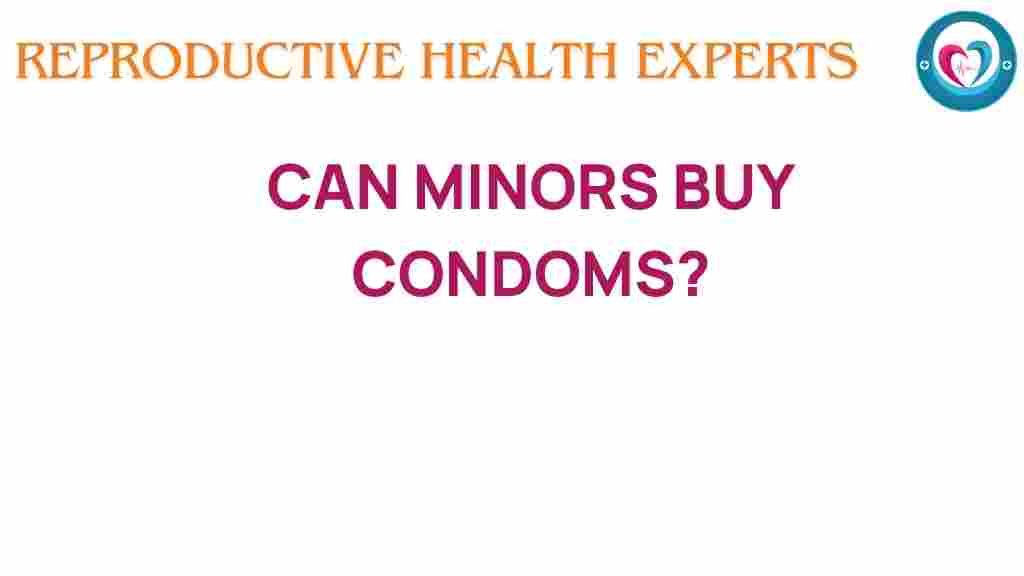The Surprising Truth: Can Minors Legally Buy Condoms?
When it comes to sexual health, one of the most important discussions centers around access to condoms. For many minors, the question arises: can they legally buy condoms? Understanding the legal framework surrounding this topic is crucial for both young individuals and their guardians. This article will explore the laws concerning minors and condom access, the importance of educational initiatives, and how to promote reproductive rights effectively.
Understanding the Legal Age and Access to Condoms
The legal age at which individuals can purchase condoms varies by country and, in some cases, by state. However, in many places, there is no legal restriction preventing minors from buying condoms. This section will break down the specifics regarding minors and their ability to access condoms.
Legal Framework in Different Regions
- United States: In the U.S., most states do not impose age restrictions on the purchase of condoms. Minors can typically buy condoms at pharmacies, supermarkets, and convenience stores without parental consent.
- United Kingdom: In the UK, anyone can buy condoms regardless of age. Additionally, many schools provide free condoms to students as part of sexual health education programs.
- Canada: Similar to the U.S. and UK, there are no age restrictions on purchasing condoms in Canada, promoting sexual health access for minors.
- Australia: In Australia, minors can also buy condoms without restrictions, reinforcing the importance of sexual health education.
Why Access to Condoms is Essential for Minors
The ability for minors to purchase condoms is a crucial aspect of sexual health and education. Here are some vital reasons why access is essential:
- Prevention of STIs: Condoms are effective in reducing the risk of sexually transmitted infections (STIs). By making condoms accessible, we empower minors to protect their health.
- Unplanned Pregnancies: Access to condoms helps in preventing unplanned pregnancies, a significant concern for adolescents.
- Promoting Safe Practices: Educating minors about safe sex practices and making condoms readily available encourages responsible behavior.
The Importance of Sexual Health Education
While access to condoms is vital, it must be complemented by comprehensive sexual health education. This education should cover various topics, including consent, reproductive rights, and safe practices. Below are key components of effective sexual health education for minors:
Components of Effective Sexual Health Education
- Understanding Consent: Teaching minors about consent is crucial. They must learn that consent is mandatory in all sexual encounters and that it can be revoked at any time.
- Knowledge of Reproductive Rights: Educating minors about their reproductive rights empowers them to make informed choices regarding their bodies and health.
- Safe Sex Practices: Discussing the importance of using condoms and other contraceptives is essential for fostering responsible sexual behavior.
- Access to Resources: Minors should be aware of where to find sexual health resources, including clinics and counseling services.
Step-by-Step Process for Minors to Access Condoms
For minors looking to purchase condoms, the process is generally straightforward. Here’s a step-by-step guide:
Step 1: Identify a Store
Locate a pharmacy, supermarket, or convenience store that sells condoms. Most retail locations have a section dedicated to sexual health products.
Step 2: Choose the Right Product
Minors can select from various condom types, including:
- Latex condoms
- Polyurethane condoms
- Polyisoprene condoms
Choosing the right product may depend on personal preferences, allergies, or sensitivity.
Step 3: Purchase the Condoms
Approach the cash register and purchase the condoms. There is no need for identification, and minors can buy condoms discreetly. If they feel uncomfortable, they can also opt for online shopping, where many retailers sell condoms without age verification.
Step 4: Educate Yourself
Once minors have access to condoms, it’s essential to educate themselves about their proper use:
- Read the instructions on the condom package.
- Understand how to properly store and use condoms to ensure effectiveness.
- Be aware of the expiration date on the packaging.
Troubleshooting Tips for Minors
Minors may encounter challenges when accessing condoms or using them. Here are some troubleshooting tips:
Feeling Embarrassed
It is common to feel embarrassed when buying condoms. Here are some tips to overcome this:
- Practice positive self-talk: Remind yourself that purchasing condoms is a responsible decision.
- Bring a friend: Having a supportive friend can make the experience less intimidating.
Access Issues
If a minor faces difficulties accessing condoms, consider the following:
- Seek local sexual health clinics that may provide free condoms.
- Look for community programs that distribute sexual health products.
- Utilize online retailers that offer discreet shipping options.
Questions About Usage
If minors have questions about how to use condoms properly, they can:
- Consult educational websites that provide reliable information.
- Speak with trusted adults or healthcare providers.
- Participate in sexual health workshops offered at schools or community centers.
Conclusion
In conclusion, minors can legally access condoms in many regions without restrictions, which is a vital aspect of promoting sexual health. Ensuring that minors have access to condoms, combined with comprehensive sexual health education, is essential for preventing STIs and unplanned pregnancies. By understanding the laws surrounding condom access and the importance of education, we can empower minors to make informed decisions regarding their sexual health.
For more information on sexual health education, check out these valuable resources. Remember, education and access are key components in fostering a healthier future for our youth.
To learn more about reproductive rights and how to advocate for them, visit this informative page.
This article is in the category Prevention and created by ReproductiveHealthExperts Team

1 thought on “The Surprising Truth: Can Minors Legally Buy Condoms?”